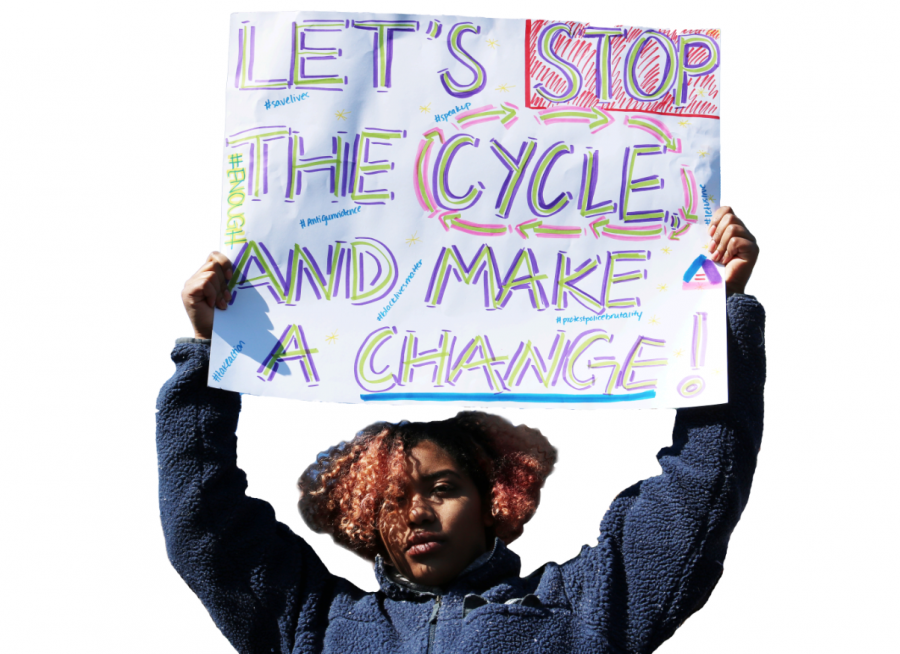Students walk out to demand tighter gun control laws
March 23, 2018
Enough.
One month later, students were still furious; they were still scared. At 10 a.m. on March 14, thousands of Evanston students flooded out of the school.
As a way of channeling their anger into action, student activists, along with the organizers of the Women’s March, crafted a National Walkout, a protest designated to call on Congress to make stricter gun control laws and honor the victims of the Parkland school shooting. ETHS was one of the thousands of schools who participated.
“There was a bunch of stuff floating around social media from ETHS students saying they would be interested in doing this,” student representative Emma Stein says. “But there wasn’t really anyone taking charge until Student Senate started organizing and planning everything.”
Upon leaving the school and walking to Lazier Field, peaceful protesters listened from the bleachers as Stein began with a speech, followed by speakers including junior Liana Wallace, senior Ari Badr, senior Genevieve Lindley, senior Sofia Garcia Garbuno, junior Max Layden and junior Josh Peng.
“Our voices ring out for the 3457 shooting victims in Chicago victims last year alone,” Stein said. “Our voices ring out for Dajae Coleman. Our voices ring out for Benjamin Bradford-Mandujano. Our voices ring out for Yakez Semark. Our voices ring out for Kaylyn Pryor.”
Wallace, who spoke after Stein, delivered a powerful poem that underscored how the international attention towards the walkout should attend to the history of gun violence as it disproportionately affects minority communities.
“After hearing the comments about the Parkland shooting repeatedly use terms like ‘mental illness’ and ‘see something say something’ without ever mentioning cracking down on guns, I was furious,” she says. “People in communities of color die everyday from gun violence, and it’s never before caused a national walkout.”
Speakers also called attention to the upcoming gubernatorial election.
“Our current governor is more worried about his next election in November than our own lives and our own people,” Garcia said in her speech. “So please take action, enough is enough.”
Additionally, the notion of student action was reiterated through- out the protest.
“This is our education, this is our life and we need to take charge of it because students ultimately have all the power in this school. When we come together on an organized, agreeable front then we can get anything we want done,” Lindley said after the walkout.
“I’ve heard a lot of stereotypes about how this young generation shouldn’t be talking about politics, but I think it’s important that we stand up for what we believe in,” freshman protester Julia Bondi added.
The walkout ended with Peng calling for student action, allotting a designated time slot for calling representatives.
Although the walkout was effective in heightening the conversation about gun control and student activism, the conversation quickly shifted, manifesting into a controversy. Some questioned the actual effectiveness of a protest if the ad- ministration was on board.
“If you look at walkouts throughout the past, they have a history of being disruptive and disobedient,” junior Izzy Colbert wrote in an Instagram post on March 12. “Part of what draws so much attention and respect, or disrespect, to the people who participate is the fact that they are willing to face the consequences no matter what.”
With administration on board, March 14 became a C-day. The extra time added to third period accommodated the walkout, which took place shortly after third period started.
Yet, others believe that despite the administration’s support, this walkout remains a symbol of public resistance and a call to action.
“I don’t think the school did it as a way to diminish the impact that students have on the walkout,” junior Senator Phoebe Liccardo says. “I think they were doing it to show support of student activism and leadership.”
Liccardo added that it’s important to remember that although there weren’t extreme consequences, third period was marked as an unexcused absence for those who participated.
“It’s important that what you are protesting aligns with who you are protesting,” Stein adds. “We were not protesting the school administration. We were protesting the state government and the national government.”
Punishment among protesters differ depending on the school, but extreme consequences may not be legally justified.
In the 1969, Tinker v. Des Moines Independent Community School District court case regarding Vietnam War protesters in school, the Supreme Court ruled that students are still entitled to the freedom of speech, even within the walls of a public school.
According to Vox’s coverage of student protests earlier this month, “The justices said that school administrators cannot punish students merely for expressing political views. They can only discipline students if their speech or actions cause ‘material’ or ‘substantial’ disruption to school functions.”
More criticism directed at some participants who allegedly did not take the walkout seriously also arose.
“Some people were on their phones, talking to one another and not paying attention,” junior pro- tester Isadore Lobin says. “Those who were goofing off definitely had the right to be there, but I think they were misusing that right.”
Hours after students returned back to school, ETHS was put on a soft lockdown due to word of a gunman within the community.
According to WGN-TV, “Police said they got a call from an individual claiming to have shot his girlfriend in the area of Emerson Street and Maple Avenue.”
At 3:16pm, after confirming that the call was a swatting incident, administrators notified students and staff of an all-clear and the school day continued on regularly.
The National Walkout will go down in history as a day of solidarity and activism through student voice. However, the fight is not over; there are a multitude of ways students can make a change post- walkout.
On Saturday, March 24, the “March For Our Lives” protest in Washington D.C. will take place. Students can also attend the walkout on April 20, a protest signifying the 19th anniversary of the Columbine shooting.
The protest will begin at 10 a.m. at schools and universities nationally. Students are encouraged to wear the color orange to honor gun violence victim Hadiya Pendleton who was shot in 2015 at just 15 years old.
Students are strongly urged to call their representatives to demand tighter gun control. One way of go- ing about this is by utilizing an app called “5 Calls”. This app not only provides people with their representatives’ phone numbers but also supplies scripts they can directly read from.
“I think this was a great entry into the world of activism for students to speak up about an issue that directly affects our age group,” Stein says. “This is an issue that our government has not been honoring and we need to hold people in power accountable for that.”











